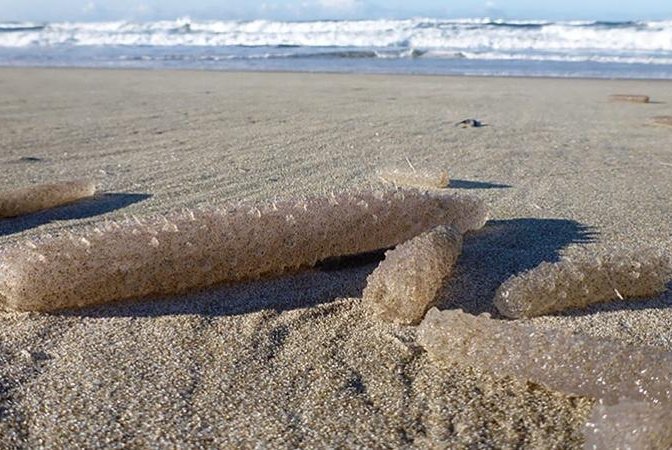Sea pickles by the dozens can be found washed up on the beaches of Oregon. Photo by University of Oregon
July 20 (UPI) -- Sea pickles have been invading the waters along the coast of the Pacific Northwest for a few years. Now, new research suggests the cucumber-shaped colonial jellies, called pyrosomes, are here to stay.
The pickles are bioluminescent -- pyrosome translates as "fire body." Each tube-like creature is actually many creatures, a colony of multi-celled organisms call zooids.
"These animals may be able to survive in colder water than we previously thought possible, but what might really be contributing to their continued presence is that the food source off of our coast is right for them," Kelly Sutherland, a marine biologist at the University of Oregon, said in a news release.
Sutherland and her researcher partners believe the lack of upwelling in the ocean has made for pickle-friendly conditions.
"The last few years have been relatively warm," Sutherland said. "The warmth on the surface tends to keep colder, denser, nutrient-rich water from reaching the surface; it's an oil-and-water kind of situation."
The lack of nutrients has resulted in a glut of smaller food particles, fuel for invading pickle colonies.
Recent research cruises revealed large numbers of sea pickles in three separate locations, 6, 15 and 28 miles off Oregon's northern coast. The colonies were found 130 feet beneath the ocean surface, at the base of the ocean's top layer.
Sutherland and her colleagues detailed the results of their expeditions this week in the journal Ecology.
Each tube-like creature is actually many creatures, a colony of multi-celled organisms call zooids.
Scientists have observed a variety of animals, including fish, birds and turtles, feeding on the pickles. Fishing nets have brought hundreds to the surface. Last spring, a research vessel netted 60,000 pyrosomes in five minutes.
Their prolonged presence and accelerated growth suggests the pickles aren't temporary invaders, but have settled in and adapted. The phenomenon could be evidence of a shift in the dynamics of the local food chain.
"What we are seeing could be systemic of larger changes in the ecosystem," Sutherland said.
Rising temperatures and prolonged marine heat waves in the Pacific have been blamed for a variety of strange animal behavior and ecological changes over the last few years. Strange may be the new normal.















